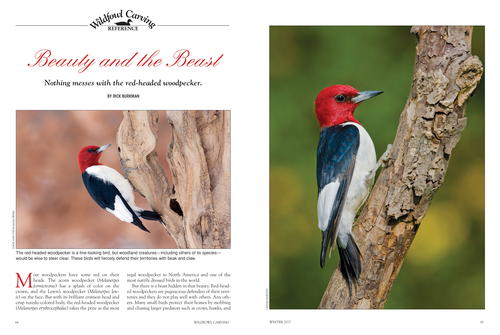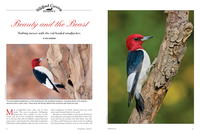Beauty and the Beast
Nothing messes with the red-headed woodpecker.

Regular contributor Rick Burkman started watching birds at a young age 50 years ago. Many years later he began a professional writing career and has written for bird magazines, regional magazines, and newspapers. He currently serves on the planning team and communications committee for the Wisconsin Breeding Bird Atlas II, and conducts regular field surveys for breeding birds.
Most woodpeckers have some red on their heads. The acorn woodpecker (Melanerpes formicivorus) has a splash of color on the crown, and the Lewis’s woodpecker (Melanerpes lewis) on the face. But with its brilliant crimson head and crisp tuxedo-colored body, the red-headed woodpecker (Melanerpes erythrocephalus) takes the prize as the most regal woodpecker in North America and one of the most nattily dressed birds in the world.
But there is a beast hidden in that beauty. Red-headed woodpeckers are pugnacious defenders of their territories, and they do not play well with others. Any others. Many small birds protect their homes by mobbing and chasing larger predators such as crows, hawks, and owls. Several also ensure adequate food and shelter by defending their territories from their own kind, especially during the nesting season. Red-headed woodpeckers take this protection a step further by attacking both predators and all other cavity-nesting birds in the area. European starlings, kestrels, swallows, and wrens venture at their own risk into space that the woodpeckers have claimed. It does not matter if the other birds were there first—the woodpeckers will chase out the inhabitants, break up their nests, and eat or puncture any eggs they find. A single pair of red-headed woodpeckers can wipe out an entire colony of cliff swallows. Size is not important to this belligerent protector: the woodpeckers will destroy wood duck nests and stab the eggs in racing-pigeon houses and chicken coops. At one time, this bird’s aggressive nature gave it an honored spot in the Native American Cherokee tribes as a symbol of aggressiveness and bravery in war, but in today’s world, this neighborhood jewel doubles as the neighborhood bully.
This article is from the Winter 2017 issue. For more information on our issues, check out our issues page.
Read NextBig Birds



